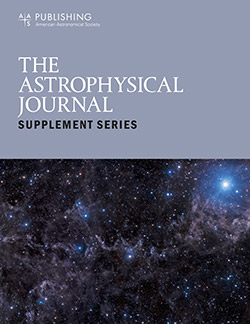X-Ray Spectral Characterization of the Young Cygnus OB2 Population
IF 8.6
1区 物理与天体物理
Q1 ASTRONOMY & ASTROPHYSICS
引用次数: 5
Abstract
Abstract We analyze the X-ray spectra of the ∼8000 sources detected in the Cygnus OB2 Chandra Legacy Survey (this focus issue), with the goals of characterizing the coronal plasma of the young low-mass stars in the region and estimating their intrinsic X-ray luminosities. We adopt two different strategies for X-ray sources for which more or less than 20 photons were detected. For the brighter sample we fit the spectra with absorbed isothermal models. In order to limit uncertainties, for most of the fainter Cygnus OB2 members in this sample we constrain the spectral parameters to characteristic ranges defined from the brightest stars. For X-ray sources with <20 net photons we adopt a conversion factor from detected photon flux to intrinsic flux. This was defined, building on the results for the previous sample, as a function of the 20% quantile of the detected photon energy distributions, which we prove to also correlate well with extinction. We then use the X-ray extinction from the spectral fits to constrain the ratio between optical and X-ray extinction toward Cyg OB2, finding it consistent with standard “Galactic” values, when properly accounting for systematics. Finally, we exploit the large number of sources to constrain the average coronal abundances of several elements, through two different ensemble analyses of the X-ray spectra of low-mass Cyg OB2 members. We find the pattern of abundances to be largely consistent with that derived for the young stellar coronae in the Orion Nebula Cluster.年轻天鹅座OB2星群的x射线光谱特征
我们分析了天鹅座OB2钱德拉遗产巡天中探测到的~ 8000个源的x射线光谱,目的是表征该区域年轻低质量恒星的日冕等离子体并估计它们的固有x射线光度。我们采用了两种不同的策略对x射线源大于或小于20个光子的检测。对于较亮的样品,我们用吸收等温模型拟合光谱。为了限制不确定性,对于本样本中大多数较暗的天鹅座OB2成员,我们将光谱参数限制在最亮恒星定义的特征范围内。对于净光子为<20的x射线源,我们采用从检测光子通量到本征通量的转换因子。这是根据前一个样本的结果定义的,作为检测到的光子能量分布的20%分位数的函数,我们证明它也与消光密切相关。然后,我们使用光谱拟合的x射线消光来限制Cyg OB2的光学和x射线消光之比,发现它与标准的“银河系”值一致,当适当地考虑到系统时。最后,我们利用大量的源,通过对低质量Cyg OB2成员的x射线谱的两种不同的系综分析来约束几种元素的平均日冕丰度。我们发现丰度的模式在很大程度上与猎户座星云团中年轻恒星日冕的模式一致。
本文章由计算机程序翻译,如有差异,请以英文原文为准。
求助全文
约1分钟内获得全文
求助全文
来源期刊

Astrophysical Journal Supplement Series
地学天文-天文与天体物理
CiteScore
14.50
自引率
5.70%
发文量
264
审稿时长
2 months
期刊介绍:
The Astrophysical Journal Supplement (ApJS) serves as an open-access journal that publishes significant articles featuring extensive data or calculations in the field of astrophysics. It also facilitates Special Issues, presenting thematically related papers simultaneously in a single volume.
 求助内容:
求助内容: 应助结果提醒方式:
应助结果提醒方式:


